Impact of Hand Hygiene on Infection Rate in Hospitals
VerifiedAdded on 2023/04/20
|16
|3918
|161
AI Summary
This research project evaluates the impact of hand hygiene on the reduction of infection rate in hospitals. The study reveals that effective training and stringent infection control policies can help nursing professionals comply with hand hygiene practices. The research highlights the importance of hand hygiene in preventing healthcare-associated infections.
Contribute Materials
Your contribution can guide someone’s learning journey. Share your
documents today.
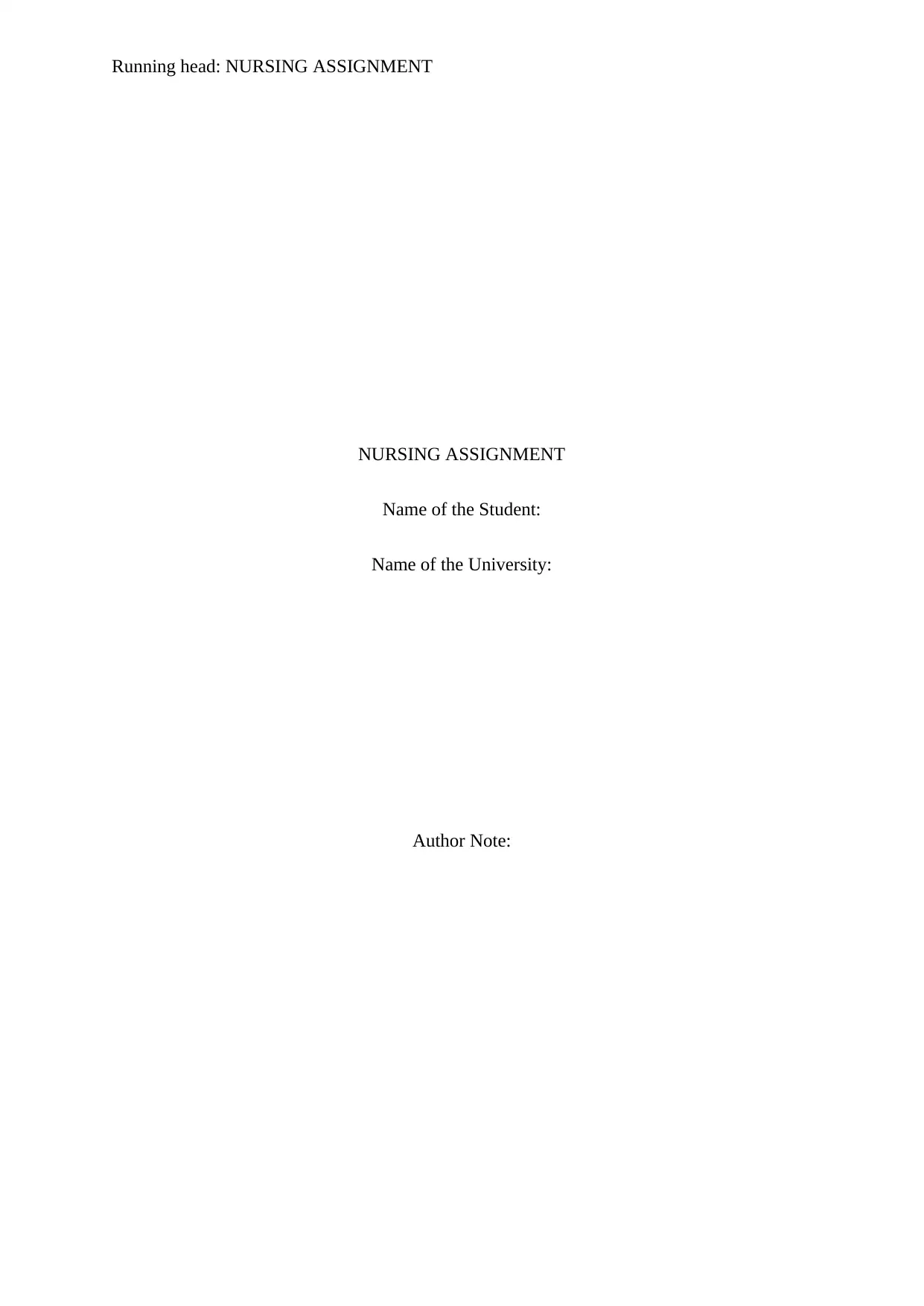
Running head: NURSING ASSIGNMENT
NURSING ASSIGNMENT
Name of the Student:
Name of the University:
Author Note:
NURSING ASSIGNMENT
Name of the Student:
Name of the University:
Author Note:
Secure Best Marks with AI Grader
Need help grading? Try our AI Grader for instant feedback on your assignments.
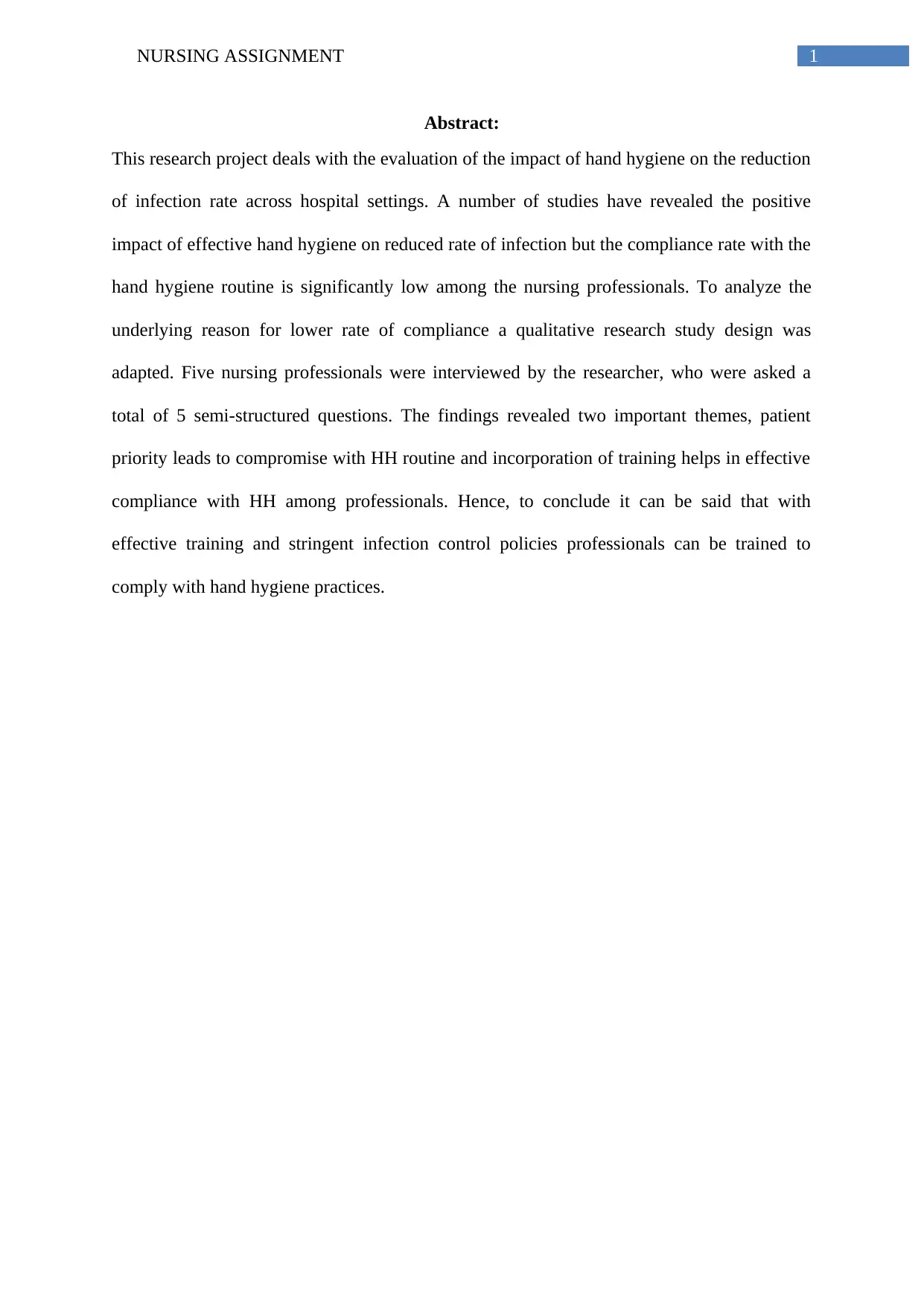
1NURSING ASSIGNMENT
Abstract:
This research project deals with the evaluation of the impact of hand hygiene on the reduction
of infection rate across hospital settings. A number of studies have revealed the positive
impact of effective hand hygiene on reduced rate of infection but the compliance rate with the
hand hygiene routine is significantly low among the nursing professionals. To analyze the
underlying reason for lower rate of compliance a qualitative research study design was
adapted. Five nursing professionals were interviewed by the researcher, who were asked a
total of 5 semi-structured questions. The findings revealed two important themes, patient
priority leads to compromise with HH routine and incorporation of training helps in effective
compliance with HH among professionals. Hence, to conclude it can be said that with
effective training and stringent infection control policies professionals can be trained to
comply with hand hygiene practices.
Abstract:
This research project deals with the evaluation of the impact of hand hygiene on the reduction
of infection rate across hospital settings. A number of studies have revealed the positive
impact of effective hand hygiene on reduced rate of infection but the compliance rate with the
hand hygiene routine is significantly low among the nursing professionals. To analyze the
underlying reason for lower rate of compliance a qualitative research study design was
adapted. Five nursing professionals were interviewed by the researcher, who were asked a
total of 5 semi-structured questions. The findings revealed two important themes, patient
priority leads to compromise with HH routine and incorporation of training helps in effective
compliance with HH among professionals. Hence, to conclude it can be said that with
effective training and stringent infection control policies professionals can be trained to
comply with hand hygiene practices.
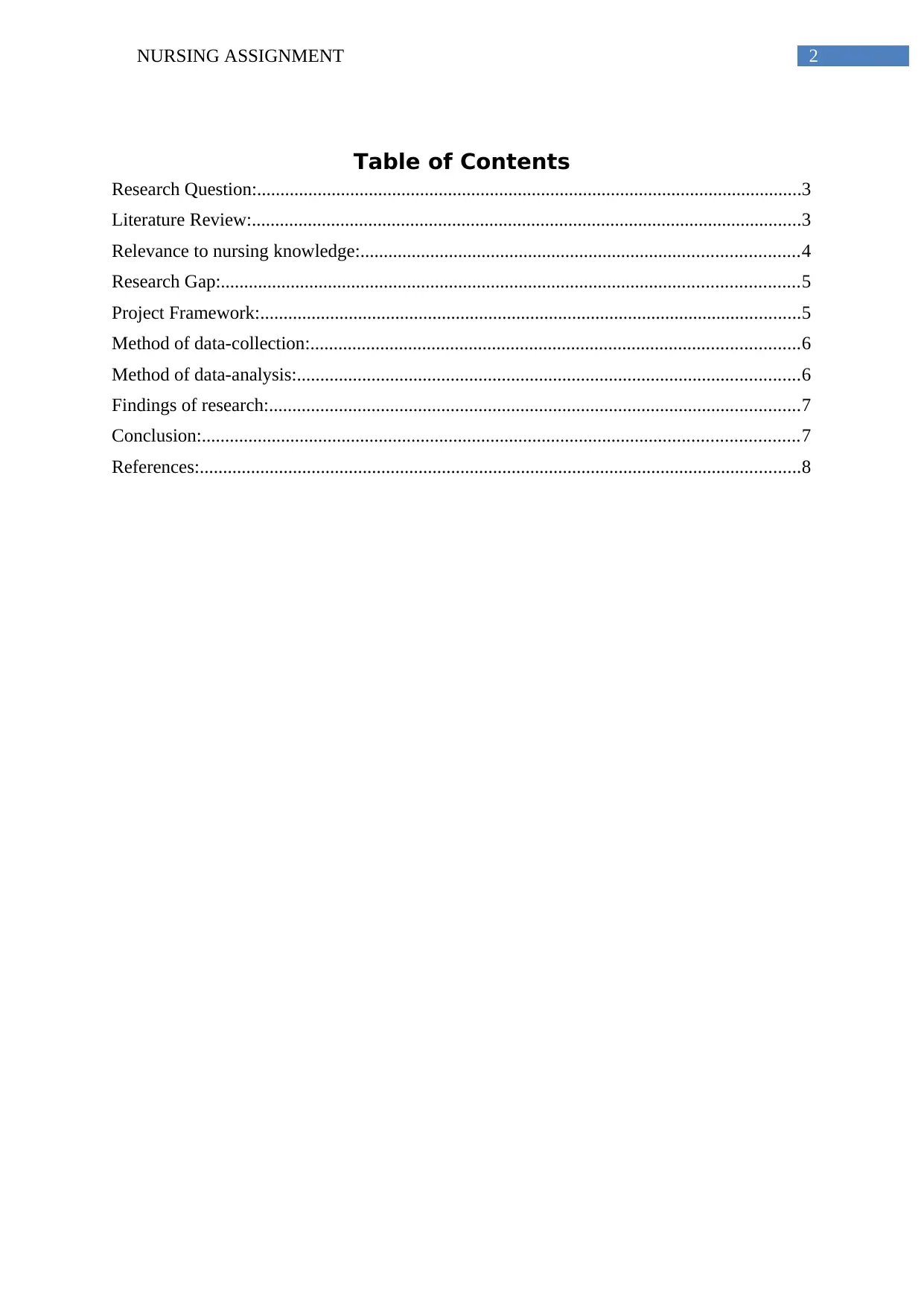
2NURSING ASSIGNMENT
Table of Contents
Research Question:.....................................................................................................................3
Literature Review:......................................................................................................................3
Relevance to nursing knowledge:..............................................................................................4
Research Gap:............................................................................................................................5
Project Framework:....................................................................................................................5
Method of data-collection:.........................................................................................................6
Method of data-analysis:............................................................................................................6
Findings of research:..................................................................................................................7
Conclusion:................................................................................................................................7
References:.................................................................................................................................8
Table of Contents
Research Question:.....................................................................................................................3
Literature Review:......................................................................................................................3
Relevance to nursing knowledge:..............................................................................................4
Research Gap:............................................................................................................................5
Project Framework:....................................................................................................................5
Method of data-collection:.........................................................................................................6
Method of data-analysis:............................................................................................................6
Findings of research:..................................................................................................................7
Conclusion:................................................................................................................................7
References:.................................................................................................................................8
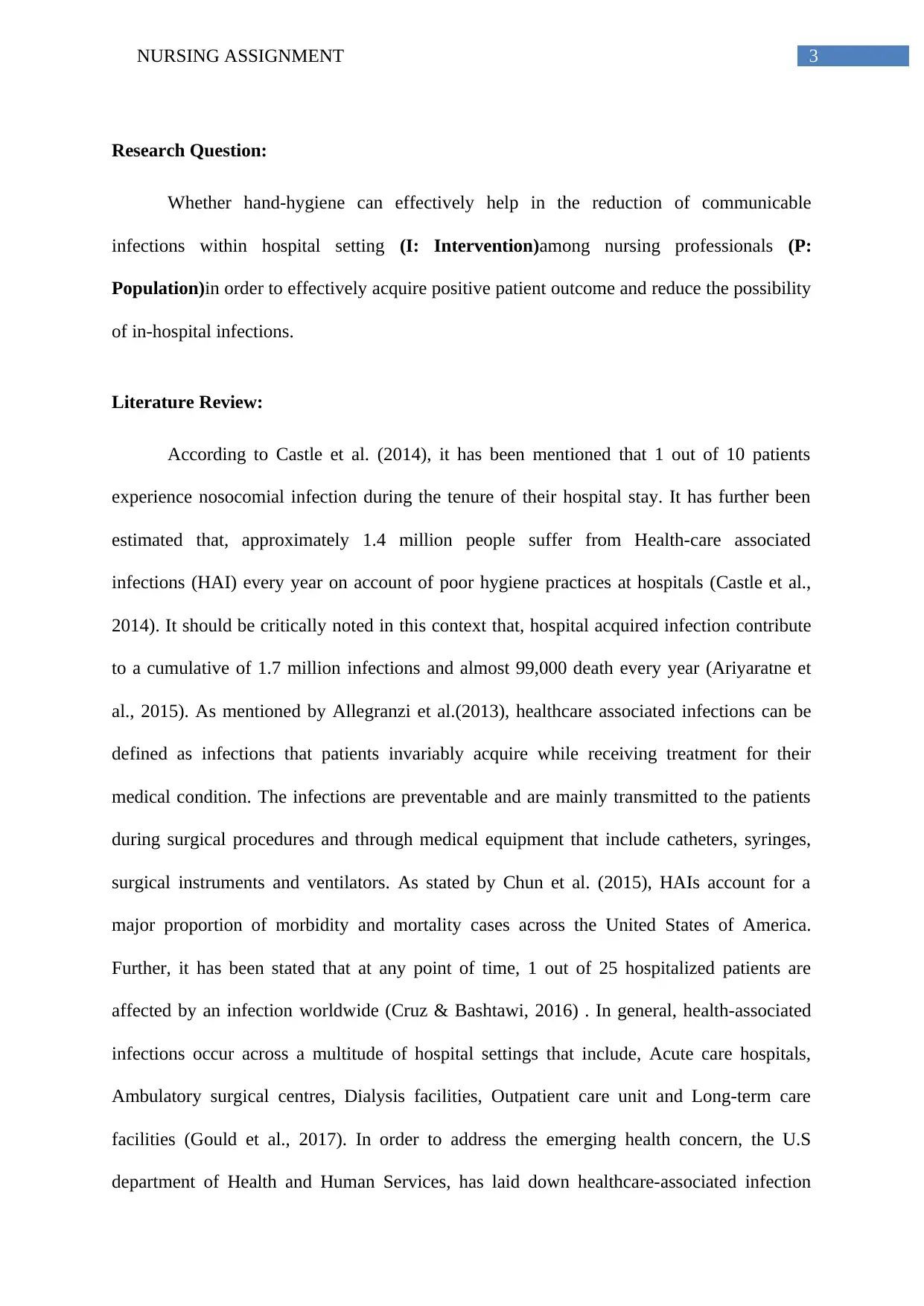
3NURSING ASSIGNMENT
Research Question:
Whether hand-hygiene can effectively help in the reduction of communicable
infections within hospital setting (I: Intervention)among nursing professionals (P:
Population)in order to effectively acquire positive patient outcome and reduce the possibility
of in-hospital infections.
Literature Review:
According to Castle et al. (2014), it has been mentioned that 1 out of 10 patients
experience nosocomial infection during the tenure of their hospital stay. It has further been
estimated that, approximately 1.4 million people suffer from Health-care associated
infections (HAI) every year on account of poor hygiene practices at hospitals (Castle et al.,
2014). It should be critically noted in this context that, hospital acquired infection contribute
to a cumulative of 1.7 million infections and almost 99,000 death every year (Ariyaratne et
al., 2015). As mentioned by Allegranzi et al.(2013), healthcare associated infections can be
defined as infections that patients invariably acquire while receiving treatment for their
medical condition. The infections are preventable and are mainly transmitted to the patients
during surgical procedures and through medical equipment that include catheters, syringes,
surgical instruments and ventilators. As stated by Chun et al. (2015), HAIs account for a
major proportion of morbidity and mortality cases across the United States of America.
Further, it has been stated that at any point of time, 1 out of 25 hospitalized patients are
affected by an infection worldwide (Cruz & Bashtawi, 2016) . In general, health-associated
infections occur across a multitude of hospital settings that include, Acute care hospitals,
Ambulatory surgical centres, Dialysis facilities, Outpatient care unit and Long-term care
facilities (Gould et al., 2017). In order to address the emerging health concern, the U.S
department of Health and Human Services, has laid down healthcare-associated infection
Research Question:
Whether hand-hygiene can effectively help in the reduction of communicable
infections within hospital setting (I: Intervention)among nursing professionals (P:
Population)in order to effectively acquire positive patient outcome and reduce the possibility
of in-hospital infections.
Literature Review:
According to Castle et al. (2014), it has been mentioned that 1 out of 10 patients
experience nosocomial infection during the tenure of their hospital stay. It has further been
estimated that, approximately 1.4 million people suffer from Health-care associated
infections (HAI) every year on account of poor hygiene practices at hospitals (Castle et al.,
2014). It should be critically noted in this context that, hospital acquired infection contribute
to a cumulative of 1.7 million infections and almost 99,000 death every year (Ariyaratne et
al., 2015). As mentioned by Allegranzi et al.(2013), healthcare associated infections can be
defined as infections that patients invariably acquire while receiving treatment for their
medical condition. The infections are preventable and are mainly transmitted to the patients
during surgical procedures and through medical equipment that include catheters, syringes,
surgical instruments and ventilators. As stated by Chun et al. (2015), HAIs account for a
major proportion of morbidity and mortality cases across the United States of America.
Further, it has been stated that at any point of time, 1 out of 25 hospitalized patients are
affected by an infection worldwide (Cruz & Bashtawi, 2016) . In general, health-associated
infections occur across a multitude of hospital settings that include, Acute care hospitals,
Ambulatory surgical centres, Dialysis facilities, Outpatient care unit and Long-term care
facilities (Gould et al., 2017). In order to address the emerging health concern, the U.S
department of Health and Human Services, has laid down healthcare-associated infection
Secure Best Marks with AI Grader
Need help grading? Try our AI Grader for instant feedback on your assignments.
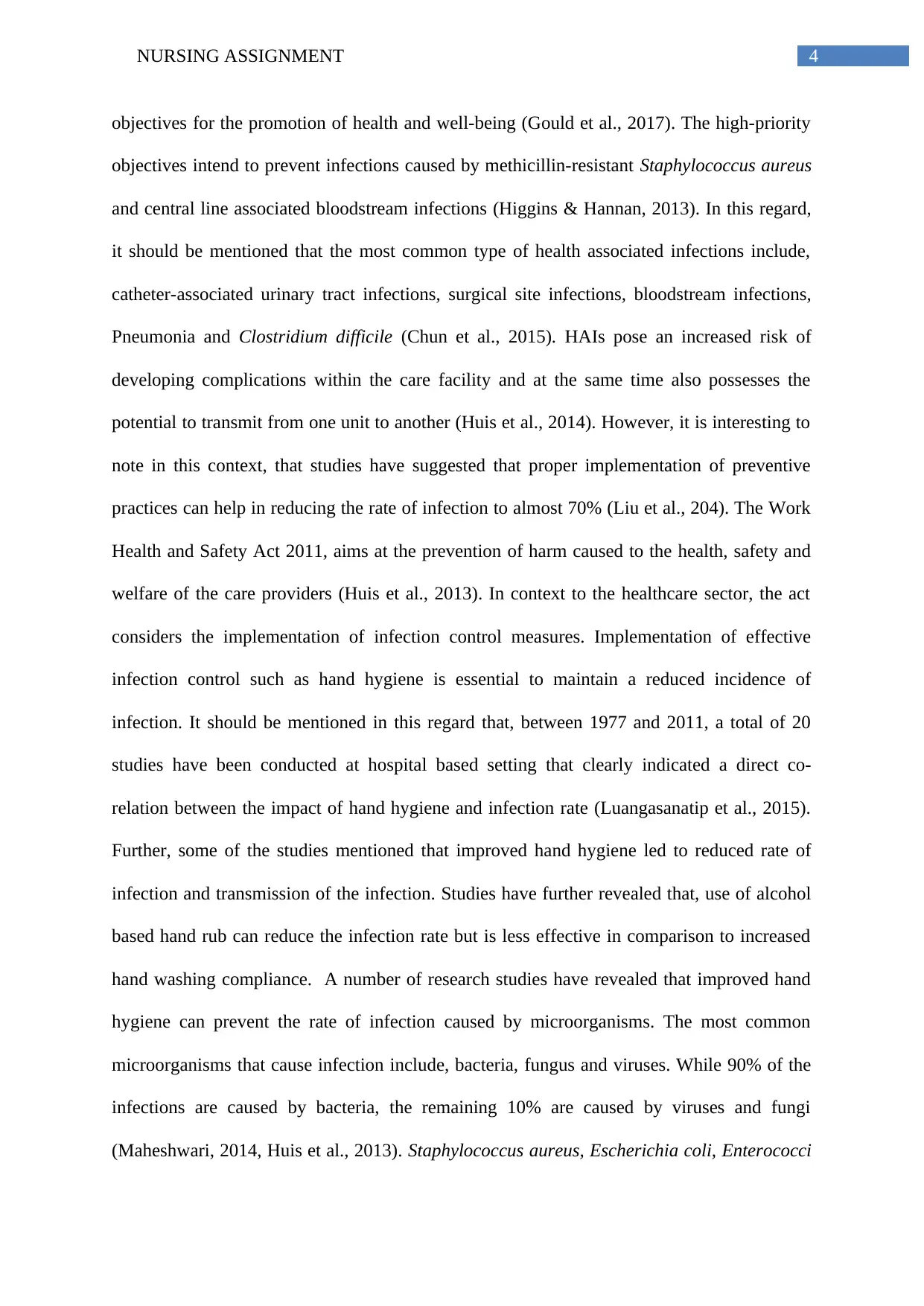
4NURSING ASSIGNMENT
objectives for the promotion of health and well-being (Gould et al., 2017). The high-priority
objectives intend to prevent infections caused by methicillin-resistant Staphylococcus aureus
and central line associated bloodstream infections (Higgins & Hannan, 2013). In this regard,
it should be mentioned that the most common type of health associated infections include,
catheter-associated urinary tract infections, surgical site infections, bloodstream infections,
Pneumonia and Clostridium difficile (Chun et al., 2015). HAIs pose an increased risk of
developing complications within the care facility and at the same time also possesses the
potential to transmit from one unit to another (Huis et al., 2014). However, it is interesting to
note in this context, that studies have suggested that proper implementation of preventive
practices can help in reducing the rate of infection to almost 70% (Liu et al., 204). The Work
Health and Safety Act 2011, aims at the prevention of harm caused to the health, safety and
welfare of the care providers (Huis et al., 2013). In context to the healthcare sector, the act
considers the implementation of infection control measures. Implementation of effective
infection control such as hand hygiene is essential to maintain a reduced incidence of
infection. It should be mentioned in this regard that, between 1977 and 2011, a total of 20
studies have been conducted at hospital based setting that clearly indicated a direct co-
relation between the impact of hand hygiene and infection rate (Luangasanatip et al., 2015).
Further, some of the studies mentioned that improved hand hygiene led to reduced rate of
infection and transmission of the infection. Studies have further revealed that, use of alcohol
based hand rub can reduce the infection rate but is less effective in comparison to increased
hand washing compliance. A number of research studies have revealed that improved hand
hygiene can prevent the rate of infection caused by microorganisms. The most common
microorganisms that cause infection include, bacteria, fungus and viruses. While 90% of the
infections are caused by bacteria, the remaining 10% are caused by viruses and fungi
(Maheshwari, 2014, Huis et al., 2013). Staphylococcus aureus, Escherichia coli, Enterococci
objectives for the promotion of health and well-being (Gould et al., 2017). The high-priority
objectives intend to prevent infections caused by methicillin-resistant Staphylococcus aureus
and central line associated bloodstream infections (Higgins & Hannan, 2013). In this regard,
it should be mentioned that the most common type of health associated infections include,
catheter-associated urinary tract infections, surgical site infections, bloodstream infections,
Pneumonia and Clostridium difficile (Chun et al., 2015). HAIs pose an increased risk of
developing complications within the care facility and at the same time also possesses the
potential to transmit from one unit to another (Huis et al., 2014). However, it is interesting to
note in this context, that studies have suggested that proper implementation of preventive
practices can help in reducing the rate of infection to almost 70% (Liu et al., 204). The Work
Health and Safety Act 2011, aims at the prevention of harm caused to the health, safety and
welfare of the care providers (Huis et al., 2013). In context to the healthcare sector, the act
considers the implementation of infection control measures. Implementation of effective
infection control such as hand hygiene is essential to maintain a reduced incidence of
infection. It should be mentioned in this regard that, between 1977 and 2011, a total of 20
studies have been conducted at hospital based setting that clearly indicated a direct co-
relation between the impact of hand hygiene and infection rate (Luangasanatip et al., 2015).
Further, some of the studies mentioned that improved hand hygiene led to reduced rate of
infection and transmission of the infection. Studies have further revealed that, use of alcohol
based hand rub can reduce the infection rate but is less effective in comparison to increased
hand washing compliance. A number of research studies have revealed that improved hand
hygiene can prevent the rate of infection caused by microorganisms. The most common
microorganisms that cause infection include, bacteria, fungus and viruses. While 90% of the
infections are caused by bacteria, the remaining 10% are caused by viruses and fungi
(Maheshwari, 2014, Huis et al., 2013). Staphylococcus aureus, Escherichia coli, Enterococci
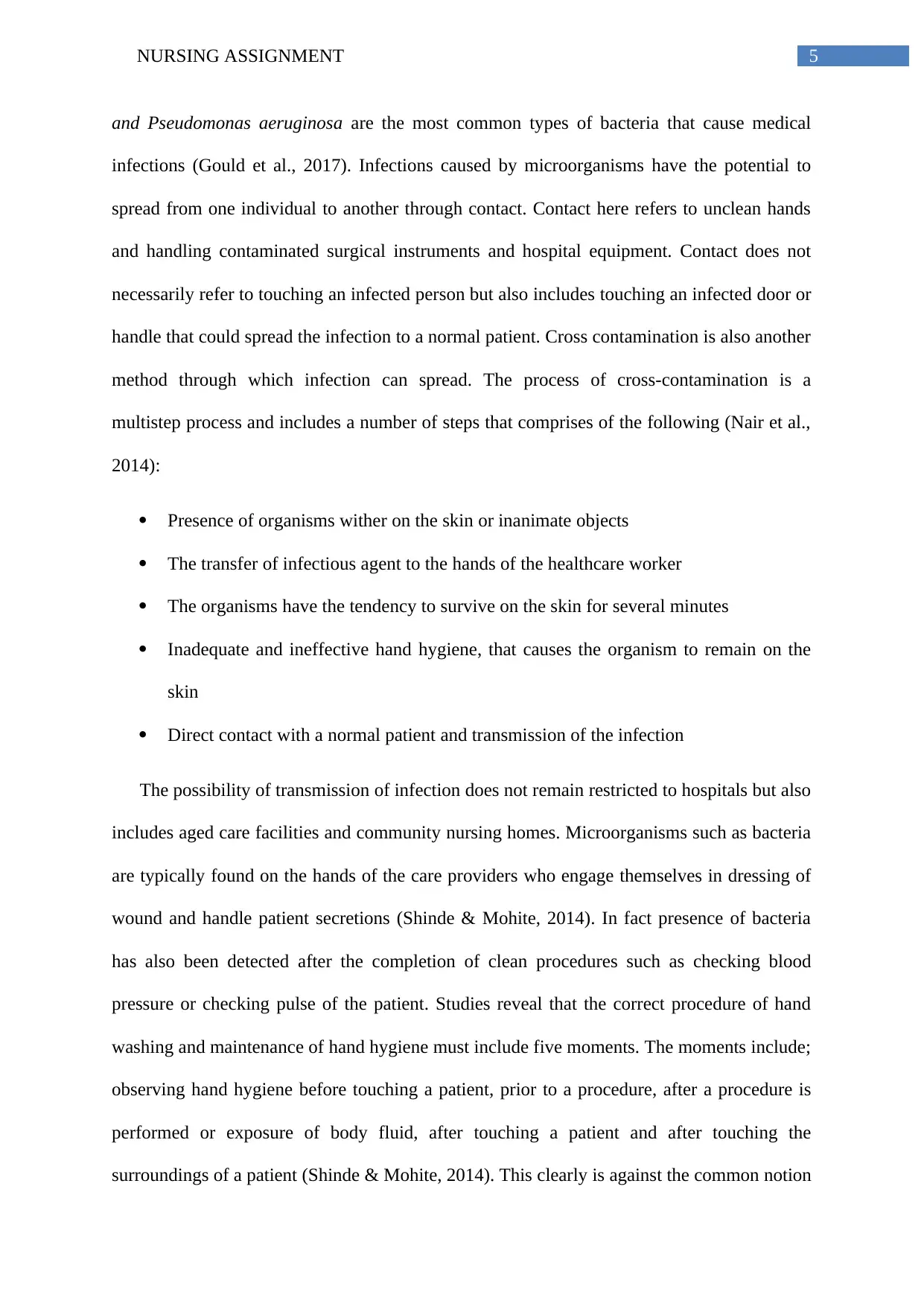
5NURSING ASSIGNMENT
and Pseudomonas aeruginosa are the most common types of bacteria that cause medical
infections (Gould et al., 2017). Infections caused by microorganisms have the potential to
spread from one individual to another through contact. Contact here refers to unclean hands
and handling contaminated surgical instruments and hospital equipment. Contact does not
necessarily refer to touching an infected person but also includes touching an infected door or
handle that could spread the infection to a normal patient. Cross contamination is also another
method through which infection can spread. The process of cross-contamination is a
multistep process and includes a number of steps that comprises of the following (Nair et al.,
2014):
Presence of organisms wither on the skin or inanimate objects
The transfer of infectious agent to the hands of the healthcare worker
The organisms have the tendency to survive on the skin for several minutes
Inadequate and ineffective hand hygiene, that causes the organism to remain on the
skin
Direct contact with a normal patient and transmission of the infection
The possibility of transmission of infection does not remain restricted to hospitals but also
includes aged care facilities and community nursing homes. Microorganisms such as bacteria
are typically found on the hands of the care providers who engage themselves in dressing of
wound and handle patient secretions (Shinde & Mohite, 2014). In fact presence of bacteria
has also been detected after the completion of clean procedures such as checking blood
pressure or checking pulse of the patient. Studies reveal that the correct procedure of hand
washing and maintenance of hand hygiene must include five moments. The moments include;
observing hand hygiene before touching a patient, prior to a procedure, after a procedure is
performed or exposure of body fluid, after touching a patient and after touching the
surroundings of a patient (Shinde & Mohite, 2014). This clearly is against the common notion
and Pseudomonas aeruginosa are the most common types of bacteria that cause medical
infections (Gould et al., 2017). Infections caused by microorganisms have the potential to
spread from one individual to another through contact. Contact here refers to unclean hands
and handling contaminated surgical instruments and hospital equipment. Contact does not
necessarily refer to touching an infected person but also includes touching an infected door or
handle that could spread the infection to a normal patient. Cross contamination is also another
method through which infection can spread. The process of cross-contamination is a
multistep process and includes a number of steps that comprises of the following (Nair et al.,
2014):
Presence of organisms wither on the skin or inanimate objects
The transfer of infectious agent to the hands of the healthcare worker
The organisms have the tendency to survive on the skin for several minutes
Inadequate and ineffective hand hygiene, that causes the organism to remain on the
skin
Direct contact with a normal patient and transmission of the infection
The possibility of transmission of infection does not remain restricted to hospitals but also
includes aged care facilities and community nursing homes. Microorganisms such as bacteria
are typically found on the hands of the care providers who engage themselves in dressing of
wound and handle patient secretions (Shinde & Mohite, 2014). In fact presence of bacteria
has also been detected after the completion of clean procedures such as checking blood
pressure or checking pulse of the patient. Studies reveal that the correct procedure of hand
washing and maintenance of hand hygiene must include five moments. The moments include;
observing hand hygiene before touching a patient, prior to a procedure, after a procedure is
performed or exposure of body fluid, after touching a patient and after touching the
surroundings of a patient (Shinde & Mohite, 2014). This clearly is against the common notion
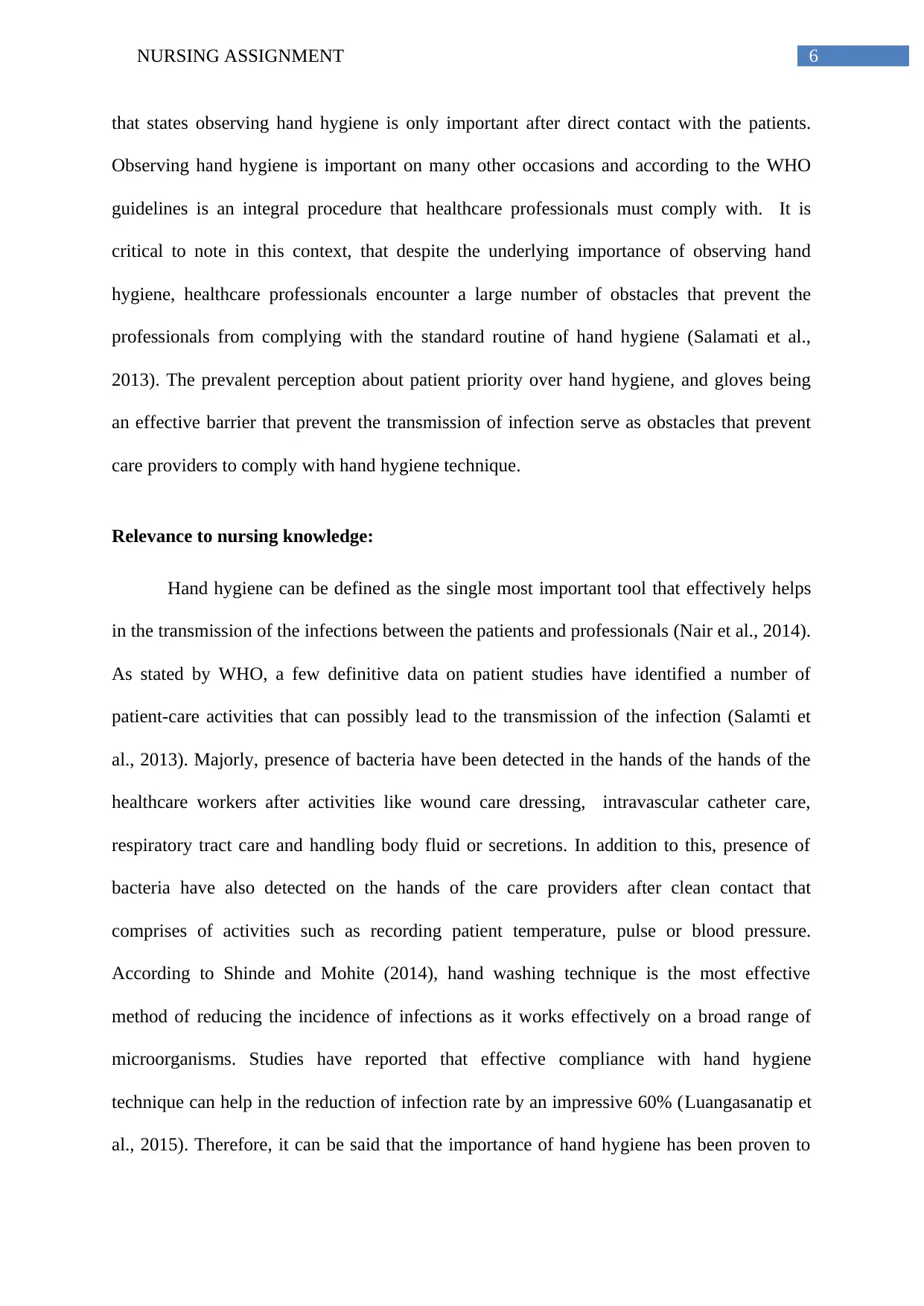
6NURSING ASSIGNMENT
that states observing hand hygiene is only important after direct contact with the patients.
Observing hand hygiene is important on many other occasions and according to the WHO
guidelines is an integral procedure that healthcare professionals must comply with. It is
critical to note in this context, that despite the underlying importance of observing hand
hygiene, healthcare professionals encounter a large number of obstacles that prevent the
professionals from complying with the standard routine of hand hygiene (Salamati et al.,
2013). The prevalent perception about patient priority over hand hygiene, and gloves being
an effective barrier that prevent the transmission of infection serve as obstacles that prevent
care providers to comply with hand hygiene technique.
Relevance to nursing knowledge:
Hand hygiene can be defined as the single most important tool that effectively helps
in the transmission of the infections between the patients and professionals (Nair et al., 2014).
As stated by WHO, a few definitive data on patient studies have identified a number of
patient-care activities that can possibly lead to the transmission of the infection (Salamti et
al., 2013). Majorly, presence of bacteria have been detected in the hands of the hands of the
healthcare workers after activities like wound care dressing, intravascular catheter care,
respiratory tract care and handling body fluid or secretions. In addition to this, presence of
bacteria have also detected on the hands of the care providers after clean contact that
comprises of activities such as recording patient temperature, pulse or blood pressure.
According to Shinde and Mohite (2014), hand washing technique is the most effective
method of reducing the incidence of infections as it works effectively on a broad range of
microorganisms. Studies have reported that effective compliance with hand hygiene
technique can help in the reduction of infection rate by an impressive 60% (Luangasanatip et
al., 2015). Therefore, it can be said that the importance of hand hygiene has been proven to
that states observing hand hygiene is only important after direct contact with the patients.
Observing hand hygiene is important on many other occasions and according to the WHO
guidelines is an integral procedure that healthcare professionals must comply with. It is
critical to note in this context, that despite the underlying importance of observing hand
hygiene, healthcare professionals encounter a large number of obstacles that prevent the
professionals from complying with the standard routine of hand hygiene (Salamati et al.,
2013). The prevalent perception about patient priority over hand hygiene, and gloves being
an effective barrier that prevent the transmission of infection serve as obstacles that prevent
care providers to comply with hand hygiene technique.
Relevance to nursing knowledge:
Hand hygiene can be defined as the single most important tool that effectively helps
in the transmission of the infections between the patients and professionals (Nair et al., 2014).
As stated by WHO, a few definitive data on patient studies have identified a number of
patient-care activities that can possibly lead to the transmission of the infection (Salamti et
al., 2013). Majorly, presence of bacteria have been detected in the hands of the hands of the
healthcare workers after activities like wound care dressing, intravascular catheter care,
respiratory tract care and handling body fluid or secretions. In addition to this, presence of
bacteria have also detected on the hands of the care providers after clean contact that
comprises of activities such as recording patient temperature, pulse or blood pressure.
According to Shinde and Mohite (2014), hand washing technique is the most effective
method of reducing the incidence of infections as it works effectively on a broad range of
microorganisms. Studies have reported that effective compliance with hand hygiene
technique can help in the reduction of infection rate by an impressive 60% (Luangasanatip et
al., 2015). Therefore, it can be said that the importance of hand hygiene has been proven to
Paraphrase This Document
Need a fresh take? Get an instant paraphrase of this document with our AI Paraphraser
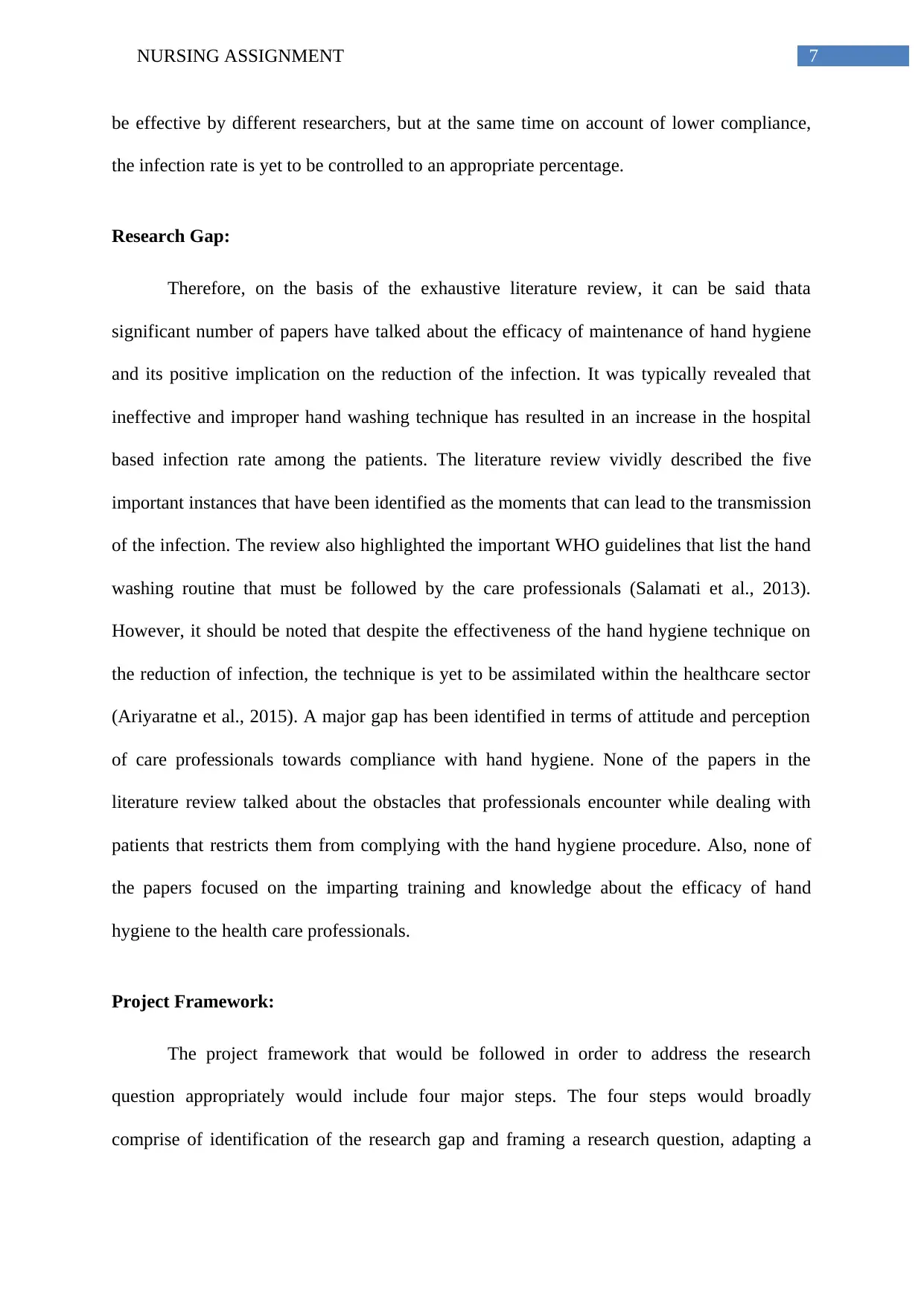
7NURSING ASSIGNMENT
be effective by different researchers, but at the same time on account of lower compliance,
the infection rate is yet to be controlled to an appropriate percentage.
Research Gap:
Therefore, on the basis of the exhaustive literature review, it can be said thata
significant number of papers have talked about the efficacy of maintenance of hand hygiene
and its positive implication on the reduction of the infection. It was typically revealed that
ineffective and improper hand washing technique has resulted in an increase in the hospital
based infection rate among the patients. The literature review vividly described the five
important instances that have been identified as the moments that can lead to the transmission
of the infection. The review also highlighted the important WHO guidelines that list the hand
washing routine that must be followed by the care professionals (Salamati et al., 2013).
However, it should be noted that despite the effectiveness of the hand hygiene technique on
the reduction of infection, the technique is yet to be assimilated within the healthcare sector
(Ariyaratne et al., 2015). A major gap has been identified in terms of attitude and perception
of care professionals towards compliance with hand hygiene. None of the papers in the
literature review talked about the obstacles that professionals encounter while dealing with
patients that restricts them from complying with the hand hygiene procedure. Also, none of
the papers focused on the imparting training and knowledge about the efficacy of hand
hygiene to the health care professionals.
Project Framework:
The project framework that would be followed in order to address the research
question appropriately would include four major steps. The four steps would broadly
comprise of identification of the research gap and framing a research question, adapting a
be effective by different researchers, but at the same time on account of lower compliance,
the infection rate is yet to be controlled to an appropriate percentage.
Research Gap:
Therefore, on the basis of the exhaustive literature review, it can be said thata
significant number of papers have talked about the efficacy of maintenance of hand hygiene
and its positive implication on the reduction of the infection. It was typically revealed that
ineffective and improper hand washing technique has resulted in an increase in the hospital
based infection rate among the patients. The literature review vividly described the five
important instances that have been identified as the moments that can lead to the transmission
of the infection. The review also highlighted the important WHO guidelines that list the hand
washing routine that must be followed by the care professionals (Salamati et al., 2013).
However, it should be noted that despite the effectiveness of the hand hygiene technique on
the reduction of infection, the technique is yet to be assimilated within the healthcare sector
(Ariyaratne et al., 2015). A major gap has been identified in terms of attitude and perception
of care professionals towards compliance with hand hygiene. None of the papers in the
literature review talked about the obstacles that professionals encounter while dealing with
patients that restricts them from complying with the hand hygiene procedure. Also, none of
the papers focused on the imparting training and knowledge about the efficacy of hand
hygiene to the health care professionals.
Project Framework:
The project framework that would be followed in order to address the research
question appropriately would include four major steps. The four steps would broadly
comprise of identification of the research gap and framing a research question, adapting a
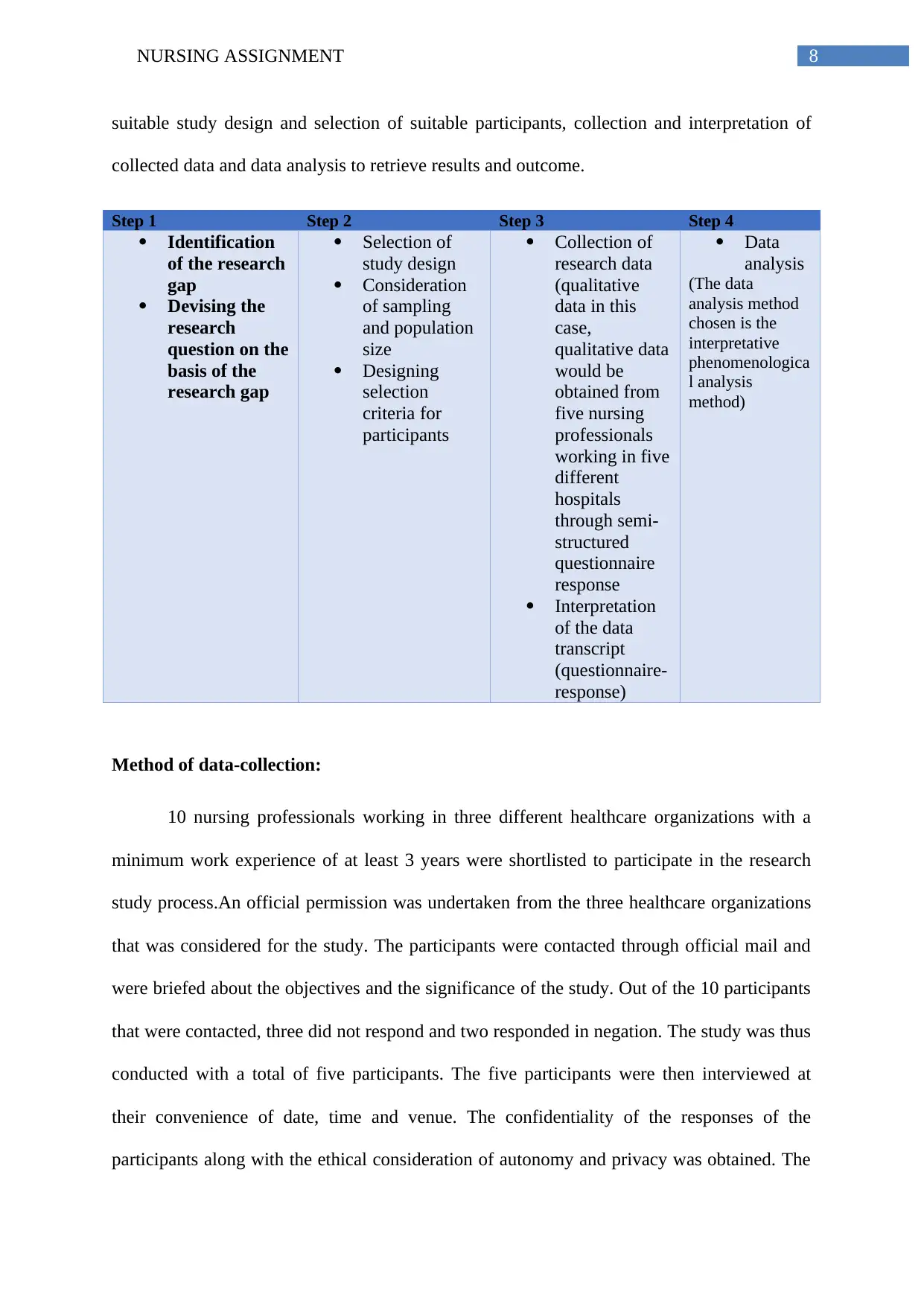
8NURSING ASSIGNMENT
suitable study design and selection of suitable participants, collection and interpretation of
collected data and data analysis to retrieve results and outcome.
Step 1 Step 2 Step 3 Step 4
Identification
of the research
gap
Devising the
research
question on the
basis of the
research gap
Selection of
study design
Consideration
of sampling
and population
size
Designing
selection
criteria for
participants
Collection of
research data
(qualitative
data in this
case,
qualitative data
would be
obtained from
five nursing
professionals
working in five
different
hospitals
through semi-
structured
questionnaire
response
Interpretation
of the data
transcript
(questionnaire-
response)
Data
analysis
(The data
analysis method
chosen is the
interpretative
phenomenologica
l analysis
method)
Method of data-collection:
10 nursing professionals working in three different healthcare organizations with a
minimum work experience of at least 3 years were shortlisted to participate in the research
study process.An official permission was undertaken from the three healthcare organizations
that was considered for the study. The participants were contacted through official mail and
were briefed about the objectives and the significance of the study. Out of the 10 participants
that were contacted, three did not respond and two responded in negation. The study was thus
conducted with a total of five participants. The five participants were then interviewed at
their convenience of date, time and venue. The confidentiality of the responses of the
participants along with the ethical consideration of autonomy and privacy was obtained. The
suitable study design and selection of suitable participants, collection and interpretation of
collected data and data analysis to retrieve results and outcome.
Step 1 Step 2 Step 3 Step 4
Identification
of the research
gap
Devising the
research
question on the
basis of the
research gap
Selection of
study design
Consideration
of sampling
and population
size
Designing
selection
criteria for
participants
Collection of
research data
(qualitative
data in this
case,
qualitative data
would be
obtained from
five nursing
professionals
working in five
different
hospitals
through semi-
structured
questionnaire
response
Interpretation
of the data
transcript
(questionnaire-
response)
Data
analysis
(The data
analysis method
chosen is the
interpretative
phenomenologica
l analysis
method)
Method of data-collection:
10 nursing professionals working in three different healthcare organizations with a
minimum work experience of at least 3 years were shortlisted to participate in the research
study process.An official permission was undertaken from the three healthcare organizations
that was considered for the study. The participants were contacted through official mail and
were briefed about the objectives and the significance of the study. Out of the 10 participants
that were contacted, three did not respond and two responded in negation. The study was thus
conducted with a total of five participants. The five participants were then interviewed at
their convenience of date, time and venue. The confidentiality of the responses of the
participants along with the ethical consideration of autonomy and privacy was obtained. The

9NURSING ASSIGNMENT
interview comprised of five questions and lasted for a period of ten minutes and the interview
was recorded using an audio recorder which was later transcribed into a hard copy format for
data interpretation.
Method of data-analysis:
The method used for analysing the data was qualitative data analysis. The interview
transcript was read and re-read a number of times in order to highlight important excerpts and
connect them to meaningful themes that were aligned to the aim of the research. This method
is known as the interpretive phenomenological analysis and is best suited for analyzing semi-
structured interviews (Smiddy et al., 2015). It helps in building new theories on existing one.
Theme 1: Patient priority leads to compromise with effective hand hygiene practices
Nurse 1: “Prioritizing patient becomes primary and many a times the routine is missed”
Nurse 2: “I think HH is not that important if I am using alcohol swabs”
Nurse 3: “HH is extremely important and it should be followed irrespective of using gloves”
Nurse 4: “If I am using gloves already, HH is secondary”
Nurse 5: “I think it is a waste of time and cuts down on the time given to the patient.”
Theme 2: Training helps in effective compliance with hand hygiene
Nurse 1: “HH training is important and helps in reducing the transmission of infection”
Nurse 2: “Training helps us in identifying events that require HH”
Nurse 3: “I am not aware of any such training”
Nurse 4: “Training is important and should be mandatory for professionals to follow”
Nurse 5: “I do not think you need training for that”
interview comprised of five questions and lasted for a period of ten minutes and the interview
was recorded using an audio recorder which was later transcribed into a hard copy format for
data interpretation.
Method of data-analysis:
The method used for analysing the data was qualitative data analysis. The interview
transcript was read and re-read a number of times in order to highlight important excerpts and
connect them to meaningful themes that were aligned to the aim of the research. This method
is known as the interpretive phenomenological analysis and is best suited for analyzing semi-
structured interviews (Smiddy et al., 2015). It helps in building new theories on existing one.
Theme 1: Patient priority leads to compromise with effective hand hygiene practices
Nurse 1: “Prioritizing patient becomes primary and many a times the routine is missed”
Nurse 2: “I think HH is not that important if I am using alcohol swabs”
Nurse 3: “HH is extremely important and it should be followed irrespective of using gloves”
Nurse 4: “If I am using gloves already, HH is secondary”
Nurse 5: “I think it is a waste of time and cuts down on the time given to the patient.”
Theme 2: Training helps in effective compliance with hand hygiene
Nurse 1: “HH training is important and helps in reducing the transmission of infection”
Nurse 2: “Training helps us in identifying events that require HH”
Nurse 3: “I am not aware of any such training”
Nurse 4: “Training is important and should be mandatory for professionals to follow”
Nurse 5: “I do not think you need training for that”
Secure Best Marks with AI Grader
Need help grading? Try our AI Grader for instant feedback on your assignments.

10NURSING ASSIGNMENT
Findings of research:
Therefore, it can be stated that the findings of the research has significantly
highlighted two important themes that include: patient priority leads to compromise with HH
routine and incorporation of training helps in effective compliance with HH among
professionals. Hence, it can be said that with effective training and stringent infection control
policies professionals can be trained to comply with hand hygiene practices.
Conclusion:
Therefore, on the basis of the discussion it can be said that the research study could
properly address the research question. Further, the study helped in the identification of the
underlying reasons that serve as barriers for professionals to comply with HH practices. Also,
it can be said that implementation of effective training programs can help in significant
infection control.
Findings of research:
Therefore, it can be stated that the findings of the research has significantly
highlighted two important themes that include: patient priority leads to compromise with HH
routine and incorporation of training helps in effective compliance with HH among
professionals. Hence, it can be said that with effective training and stringent infection control
policies professionals can be trained to comply with hand hygiene practices.
Conclusion:
Therefore, on the basis of the discussion it can be said that the research study could
properly address the research question. Further, the study helped in the identification of the
underlying reasons that serve as barriers for professionals to comply with HH practices. Also,
it can be said that implementation of effective training programs can help in significant
infection control.
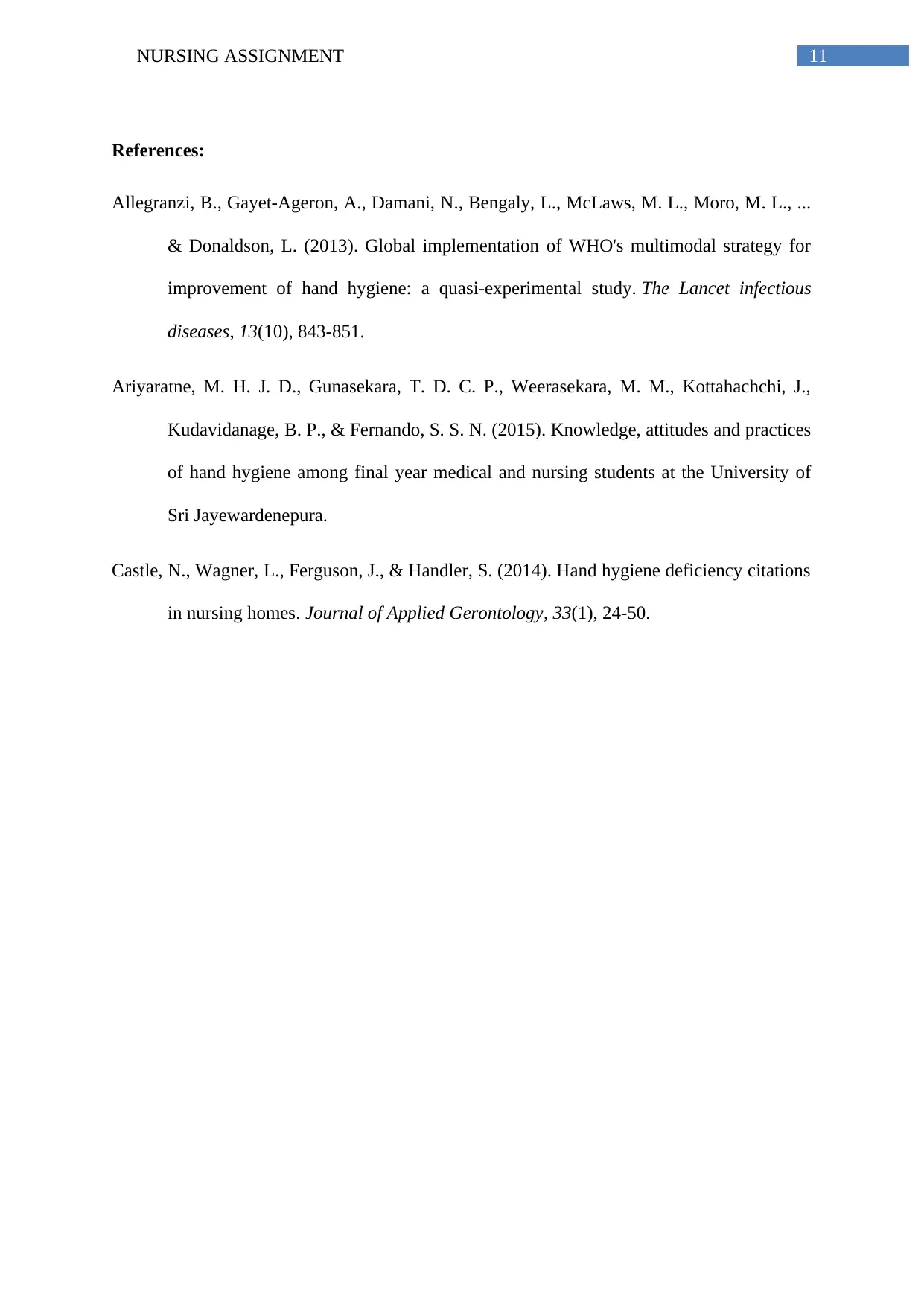
11NURSING ASSIGNMENT
References:
Allegranzi, B., Gayet-Ageron, A., Damani, N., Bengaly, L., McLaws, M. L., Moro, M. L., ...
& Donaldson, L. (2013). Global implementation of WHO's multimodal strategy for
improvement of hand hygiene: a quasi-experimental study. The Lancet infectious
diseases, 13(10), 843-851.
Ariyaratne, M. H. J. D., Gunasekara, T. D. C. P., Weerasekara, M. M., Kottahachchi, J.,
Kudavidanage, B. P., & Fernando, S. S. N. (2015). Knowledge, attitudes and practices
of hand hygiene among final year medical and nursing students at the University of
Sri Jayewardenepura.
Castle, N., Wagner, L., Ferguson, J., & Handler, S. (2014). Hand hygiene deficiency citations
in nursing homes. Journal of Applied Gerontology, 33(1), 24-50.
References:
Allegranzi, B., Gayet-Ageron, A., Damani, N., Bengaly, L., McLaws, M. L., Moro, M. L., ...
& Donaldson, L. (2013). Global implementation of WHO's multimodal strategy for
improvement of hand hygiene: a quasi-experimental study. The Lancet infectious
diseases, 13(10), 843-851.
Ariyaratne, M. H. J. D., Gunasekara, T. D. C. P., Weerasekara, M. M., Kottahachchi, J.,
Kudavidanage, B. P., & Fernando, S. S. N. (2015). Knowledge, attitudes and practices
of hand hygiene among final year medical and nursing students at the University of
Sri Jayewardenepura.
Castle, N., Wagner, L., Ferguson, J., & Handler, S. (2014). Hand hygiene deficiency citations
in nursing homes. Journal of Applied Gerontology, 33(1), 24-50.
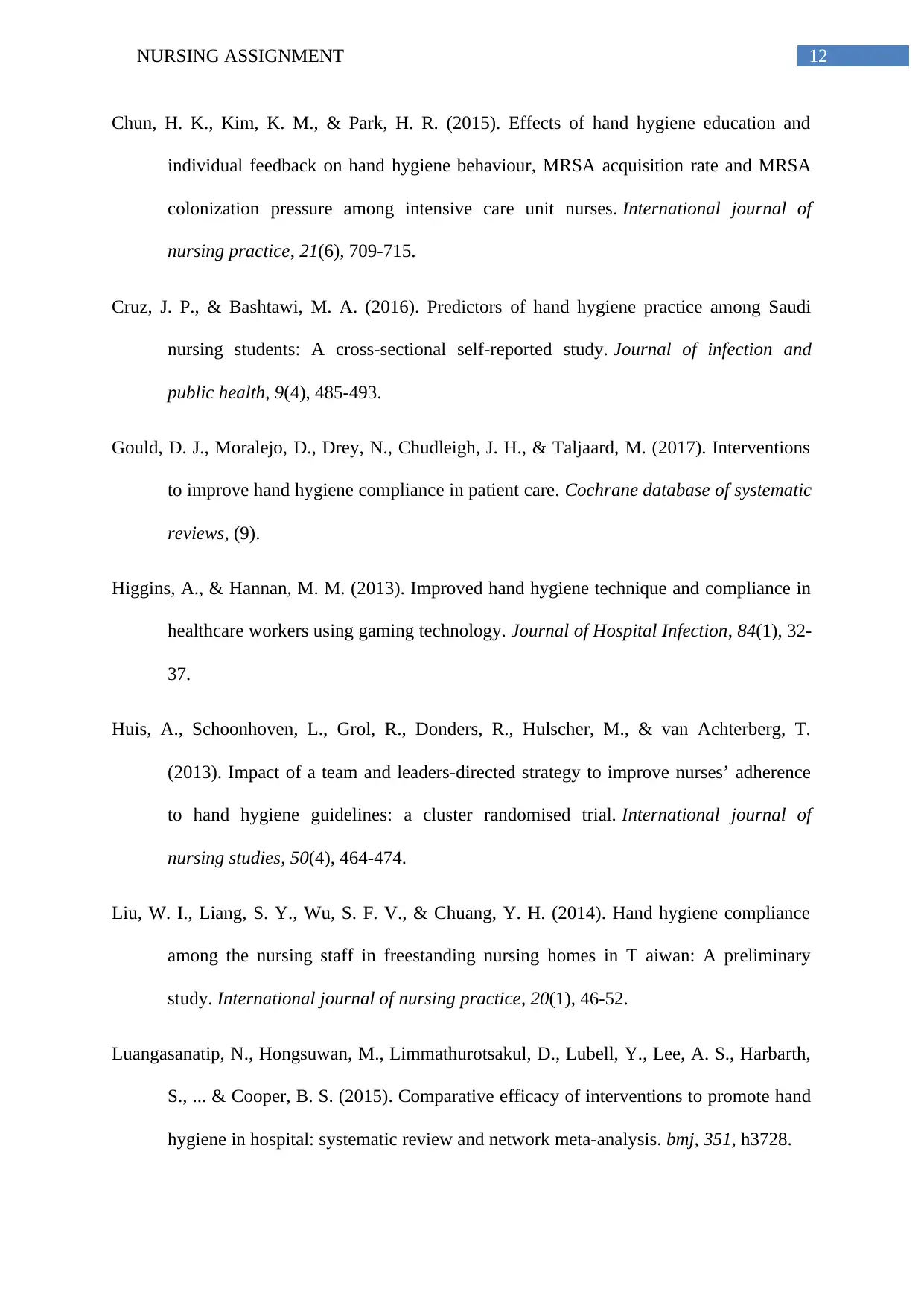
12NURSING ASSIGNMENT
Chun, H. K., Kim, K. M., & Park, H. R. (2015). Effects of hand hygiene education and
individual feedback on hand hygiene behaviour, MRSA acquisition rate and MRSA
colonization pressure among intensive care unit nurses. International journal of
nursing practice, 21(6), 709-715.
Cruz, J. P., & Bashtawi, M. A. (2016). Predictors of hand hygiene practice among Saudi
nursing students: A cross-sectional self-reported study. Journal of infection and
public health, 9(4), 485-493.
Gould, D. J., Moralejo, D., Drey, N., Chudleigh, J. H., & Taljaard, M. (2017). Interventions
to improve hand hygiene compliance in patient care. Cochrane database of systematic
reviews, (9).
Higgins, A., & Hannan, M. M. (2013). Improved hand hygiene technique and compliance in
healthcare workers using gaming technology. Journal of Hospital Infection, 84(1), 32-
37.
Huis, A., Schoonhoven, L., Grol, R., Donders, R., Hulscher, M., & van Achterberg, T.
(2013). Impact of a team and leaders-directed strategy to improve nurses’ adherence
to hand hygiene guidelines: a cluster randomised trial. International journal of
nursing studies, 50(4), 464-474.
Liu, W. I., Liang, S. Y., Wu, S. F. V., & Chuang, Y. H. (2014). Hand hygiene compliance
among the nursing staff in freestanding nursing homes in T aiwan: A preliminary
study. International journal of nursing practice, 20(1), 46-52.
Luangasanatip, N., Hongsuwan, M., Limmathurotsakul, D., Lubell, Y., Lee, A. S., Harbarth,
S., ... & Cooper, B. S. (2015). Comparative efficacy of interventions to promote hand
hygiene in hospital: systematic review and network meta-analysis. bmj, 351, h3728.
Chun, H. K., Kim, K. M., & Park, H. R. (2015). Effects of hand hygiene education and
individual feedback on hand hygiene behaviour, MRSA acquisition rate and MRSA
colonization pressure among intensive care unit nurses. International journal of
nursing practice, 21(6), 709-715.
Cruz, J. P., & Bashtawi, M. A. (2016). Predictors of hand hygiene practice among Saudi
nursing students: A cross-sectional self-reported study. Journal of infection and
public health, 9(4), 485-493.
Gould, D. J., Moralejo, D., Drey, N., Chudleigh, J. H., & Taljaard, M. (2017). Interventions
to improve hand hygiene compliance in patient care. Cochrane database of systematic
reviews, (9).
Higgins, A., & Hannan, M. M. (2013). Improved hand hygiene technique and compliance in
healthcare workers using gaming technology. Journal of Hospital Infection, 84(1), 32-
37.
Huis, A., Schoonhoven, L., Grol, R., Donders, R., Hulscher, M., & van Achterberg, T.
(2013). Impact of a team and leaders-directed strategy to improve nurses’ adherence
to hand hygiene guidelines: a cluster randomised trial. International journal of
nursing studies, 50(4), 464-474.
Liu, W. I., Liang, S. Y., Wu, S. F. V., & Chuang, Y. H. (2014). Hand hygiene compliance
among the nursing staff in freestanding nursing homes in T aiwan: A preliminary
study. International journal of nursing practice, 20(1), 46-52.
Luangasanatip, N., Hongsuwan, M., Limmathurotsakul, D., Lubell, Y., Lee, A. S., Harbarth,
S., ... & Cooper, B. S. (2015). Comparative efficacy of interventions to promote hand
hygiene in hospital: systematic review and network meta-analysis. bmj, 351, h3728.
Paraphrase This Document
Need a fresh take? Get an instant paraphrase of this document with our AI Paraphraser
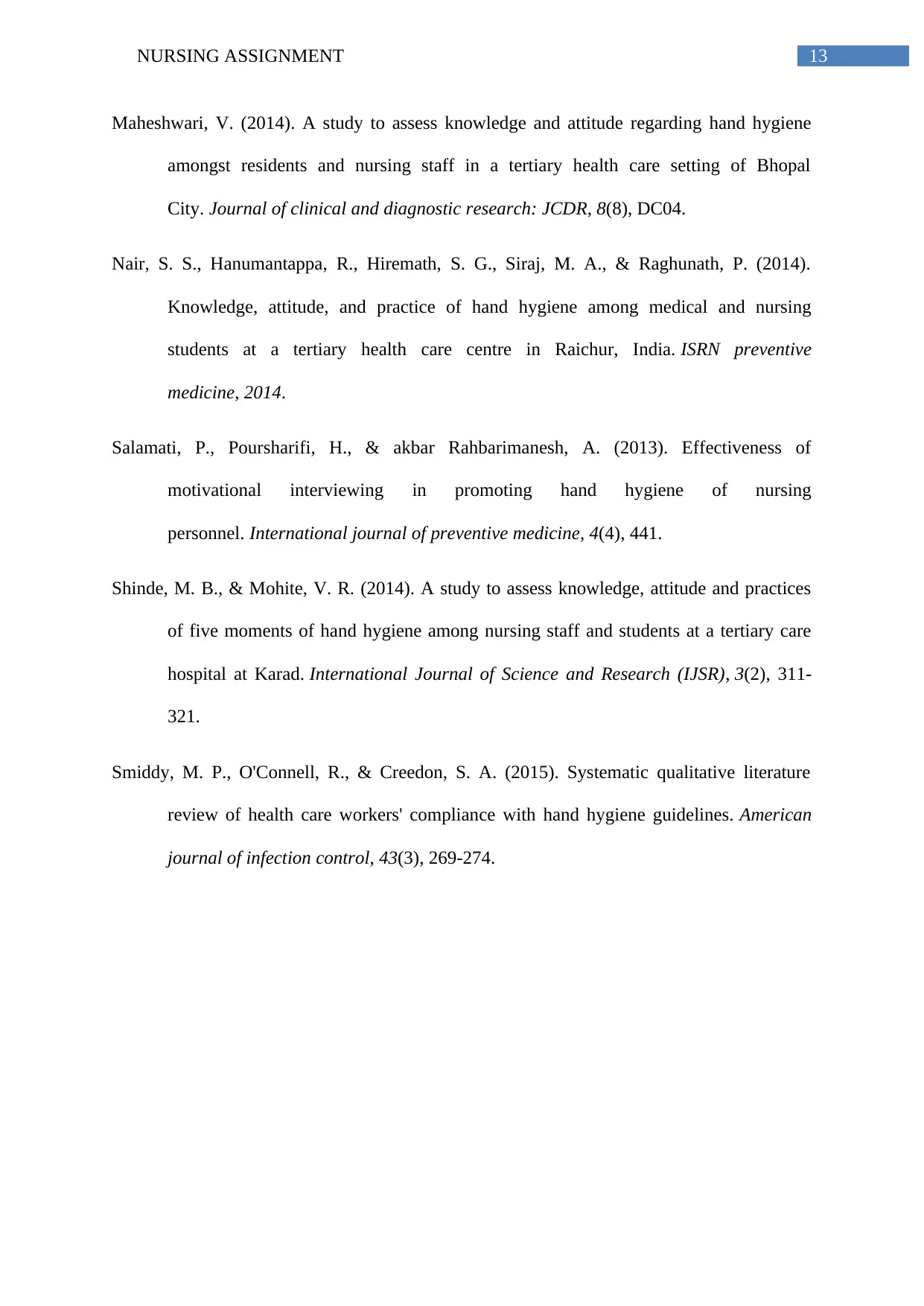
13NURSING ASSIGNMENT
Maheshwari, V. (2014). A study to assess knowledge and attitude regarding hand hygiene
amongst residents and nursing staff in a tertiary health care setting of Bhopal
City. Journal of clinical and diagnostic research: JCDR, 8(8), DC04.
Nair, S. S., Hanumantappa, R., Hiremath, S. G., Siraj, M. A., & Raghunath, P. (2014).
Knowledge, attitude, and practice of hand hygiene among medical and nursing
students at a tertiary health care centre in Raichur, India. ISRN preventive
medicine, 2014.
Salamati, P., Poursharifi, H., & akbar Rahbarimanesh, A. (2013). Effectiveness of
motivational interviewing in promoting hand hygiene of nursing
personnel. International journal of preventive medicine, 4(4), 441.
Shinde, M. B., & Mohite, V. R. (2014). A study to assess knowledge, attitude and practices
of five moments of hand hygiene among nursing staff and students at a tertiary care
hospital at Karad. International Journal of Science and Research (IJSR), 3(2), 311-
321.
Smiddy, M. P., O'Connell, R., & Creedon, S. A. (2015). Systematic qualitative literature
review of health care workers' compliance with hand hygiene guidelines. American
journal of infection control, 43(3), 269-274.
Maheshwari, V. (2014). A study to assess knowledge and attitude regarding hand hygiene
amongst residents and nursing staff in a tertiary health care setting of Bhopal
City. Journal of clinical and diagnostic research: JCDR, 8(8), DC04.
Nair, S. S., Hanumantappa, R., Hiremath, S. G., Siraj, M. A., & Raghunath, P. (2014).
Knowledge, attitude, and practice of hand hygiene among medical and nursing
students at a tertiary health care centre in Raichur, India. ISRN preventive
medicine, 2014.
Salamati, P., Poursharifi, H., & akbar Rahbarimanesh, A. (2013). Effectiveness of
motivational interviewing in promoting hand hygiene of nursing
personnel. International journal of preventive medicine, 4(4), 441.
Shinde, M. B., & Mohite, V. R. (2014). A study to assess knowledge, attitude and practices
of five moments of hand hygiene among nursing staff and students at a tertiary care
hospital at Karad. International Journal of Science and Research (IJSR), 3(2), 311-
321.
Smiddy, M. P., O'Connell, R., & Creedon, S. A. (2015). Systematic qualitative literature
review of health care workers' compliance with hand hygiene guidelines. American
journal of infection control, 43(3), 269-274.
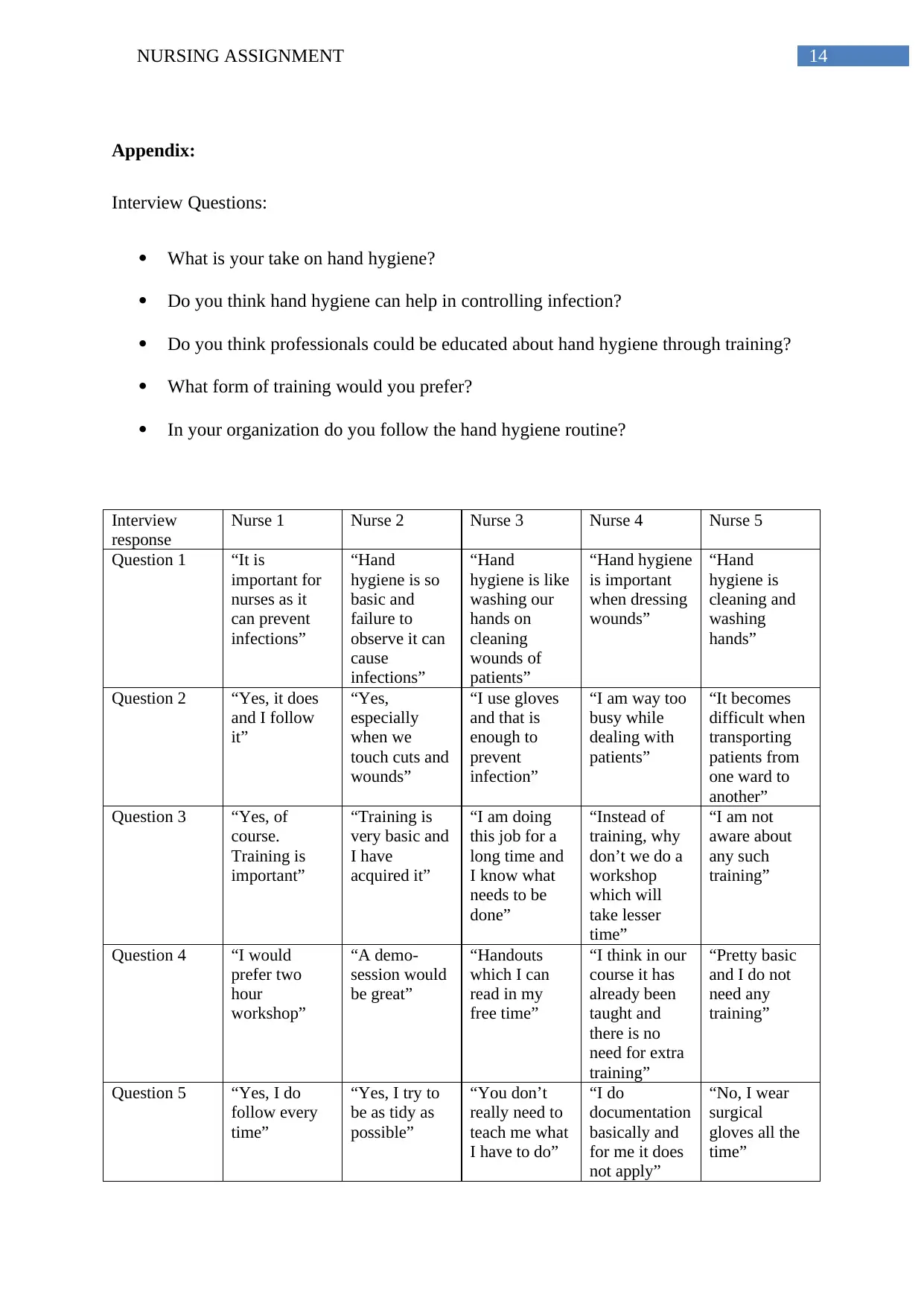
14NURSING ASSIGNMENT
Appendix:
Interview Questions:
What is your take on hand hygiene?
Do you think hand hygiene can help in controlling infection?
Do you think professionals could be educated about hand hygiene through training?
What form of training would you prefer?
In your organization do you follow the hand hygiene routine?
Interview
response
Nurse 1 Nurse 2 Nurse 3 Nurse 4 Nurse 5
Question 1 “It is
important for
nurses as it
can prevent
infections”
“Hand
hygiene is so
basic and
failure to
observe it can
cause
infections”
“Hand
hygiene is like
washing our
hands on
cleaning
wounds of
patients”
“Hand hygiene
is important
when dressing
wounds”
“Hand
hygiene is
cleaning and
washing
hands”
Question 2 “Yes, it does
and I follow
it”
“Yes,
especially
when we
touch cuts and
wounds”
“I use gloves
and that is
enough to
prevent
infection”
“I am way too
busy while
dealing with
patients”
“It becomes
difficult when
transporting
patients from
one ward to
another”
Question 3 “Yes, of
course.
Training is
important”
“Training is
very basic and
I have
acquired it”
“I am doing
this job for a
long time and
I know what
needs to be
done”
“Instead of
training, why
don’t we do a
workshop
which will
take lesser
time”
“I am not
aware about
any such
training”
Question 4 “I would
prefer two
hour
workshop”
“A demo-
session would
be great”
“Handouts
which I can
read in my
free time”
“I think in our
course it has
already been
taught and
there is no
need for extra
training”
“Pretty basic
and I do not
need any
training”
Question 5 “Yes, I do
follow every
time”
“Yes, I try to
be as tidy as
possible”
“You don’t
really need to
teach me what
I have to do”
“I do
documentation
basically and
for me it does
not apply”
“No, I wear
surgical
gloves all the
time”
Appendix:
Interview Questions:
What is your take on hand hygiene?
Do you think hand hygiene can help in controlling infection?
Do you think professionals could be educated about hand hygiene through training?
What form of training would you prefer?
In your organization do you follow the hand hygiene routine?
Interview
response
Nurse 1 Nurse 2 Nurse 3 Nurse 4 Nurse 5
Question 1 “It is
important for
nurses as it
can prevent
infections”
“Hand
hygiene is so
basic and
failure to
observe it can
cause
infections”
“Hand
hygiene is like
washing our
hands on
cleaning
wounds of
patients”
“Hand hygiene
is important
when dressing
wounds”
“Hand
hygiene is
cleaning and
washing
hands”
Question 2 “Yes, it does
and I follow
it”
“Yes,
especially
when we
touch cuts and
wounds”
“I use gloves
and that is
enough to
prevent
infection”
“I am way too
busy while
dealing with
patients”
“It becomes
difficult when
transporting
patients from
one ward to
another”
Question 3 “Yes, of
course.
Training is
important”
“Training is
very basic and
I have
acquired it”
“I am doing
this job for a
long time and
I know what
needs to be
done”
“Instead of
training, why
don’t we do a
workshop
which will
take lesser
time”
“I am not
aware about
any such
training”
Question 4 “I would
prefer two
hour
workshop”
“A demo-
session would
be great”
“Handouts
which I can
read in my
free time”
“I think in our
course it has
already been
taught and
there is no
need for extra
training”
“Pretty basic
and I do not
need any
training”
Question 5 “Yes, I do
follow every
time”
“Yes, I try to
be as tidy as
possible”
“You don’t
really need to
teach me what
I have to do”
“I do
documentation
basically and
for me it does
not apply”
“No, I wear
surgical
gloves all the
time”

15NURSING ASSIGNMENT
1 out of 16
Related Documents
Your All-in-One AI-Powered Toolkit for Academic Success.
+13062052269
info@desklib.com
Available 24*7 on WhatsApp / Email
![[object Object]](/_next/static/media/star-bottom.7253800d.svg)
Unlock your academic potential
© 2024 | Zucol Services PVT LTD | All rights reserved.





